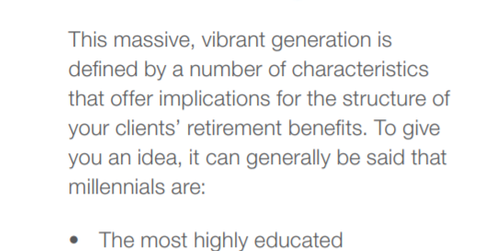Are your plan sponsor clients millennial-ready?
Over the past few decades, defined contribution (DC) plans have gradually adjusted their plan designs and investment lineups to accommodate a participant base heavily made up of baby boomers. However, a shift in plan demographics could be changing that trend — the rise of millennials as a key segment of DC plans. Born between the […]
Nov. 20 2020, Updated 1:27 p.m. ET

Over the past few decades, defined contribution (DC) plans have gradually adjusted their plan designs and investment lineups to accommodate a participant base heavily made up of baby boomers. However, a shift in plan demographics could be changing that trend — the rise of millennials as a key segment of DC plans.
Born between the early 1980s and early 2000s, millennials recently have become the largest demographic cohort in the nation.[1.U.S. Census Bureau, 2016] One-third of them have entered the workforce, and more are on the way. That means swelling numbers of younger workers are showing up on plan sponsors’ participant rosters.
What do these demographic changes mean for your plan sponsor clients’ plans? Millennials’ distinctive attitudes and behavior can warrant a fresh look at the plan, from how to communicate with them to the all-important investment lineups. Here are some ideas to help your plan sponsors decide how to respond.
Precocious savers
First the good news. Plan sponsors are facing little resistance to retirement plan participation among millennials. Fueled by doubts that Social Security will be there for them — and a keen awareness of the issues faced by their undersaved elders — millennials as a group began saving at a median age of just 22, earlier than any previous generation. Plus, more than 70% of those who have access to an employer-sponsored plan are participating, and on average they’re contributing a respectable 7% of their salaries.[2.17th Annual Transamerica Retirement Survey of Workers, 2016]
Their clear appreciation for workplace retirement benefits promises to keep plan sponsors on their toes, though. Two-thirds of millennials would consider switching employers to gain access to better retirement benefits.[2.17th Annual Transamerica Retirement Survey of Workers, 2016] To retain their younger employees, plan sponsors need to keep their plans competitive. You can help them stay ahead of the curve.
Conservative investors
But while millennials are off to a good start as savers, their investing approach may not be serving them as well. They’re stuffing almost twice as much of their savings under the mattress as they’re putting to work in the market. In fact, in one survey, millennials on average were shown to invest just 28% of their portfolios in stocks, compared with other age groups — including boomers, who are nearing or in retirement — who hold 46% in equities.[3.15th Annual Transamerica Retirement Survey of Workers, 2014]
Millennials’ risk aversion is borne out of exposure to a series of market upsets over their young lives, including the dot-com bubble, the post-9/11 crash, and the 2008-2009 recession. They’ve seen their parents lose jobs, as well as lose the value in their retirement accounts and homes. The global financial crisis eroded millennials’ trust in systems and institutions, and predisposed them to caution.
Further solidifying their world view, millennials have felt the sting of economic uncertainty in their own lives. Many of them came into the job market in times of high unemployment and a growing gig economy, when employer benefits were becoming far less certain. And many expect to be saddled with student debt for years, just one of the factors that have kept their rate of homeownership lower than any previous generation, and the largest number living with their parents since 1880.[4.Pew Research Center, 2016] Under such circumstances, millennials’ conservative approach to investing arguably can be considered quite rational.
Implications for the plan lineup
Until millennials have time to pay down student debt and accumulate comfortable balances in their emergency funds and retirement accounts, they are likely to remain reluctant to jump into stock investing with both feet. So it may make sense to analyze your clients’ investment lineups to ensure they can accommodate millennials’ conservative sensibilities. Lineups that offer target-date default options may be particularly worth careful review. These funds typically put between 80% and 100% of younger workers’ assets into stock, which may not be well matched to the needs of this risk-averse generation.
Of course, the glide paths of these funds generally are based on sound rationale: early-career investors have more time to wait out the ups and downs of the market in hopes of gaining higher returns. But that approach is effective only if investors stay put through thick and thin. Panicked exchanges into cash equivalents, shown to be favored by millennials, could have adverse and long-term consequences.
